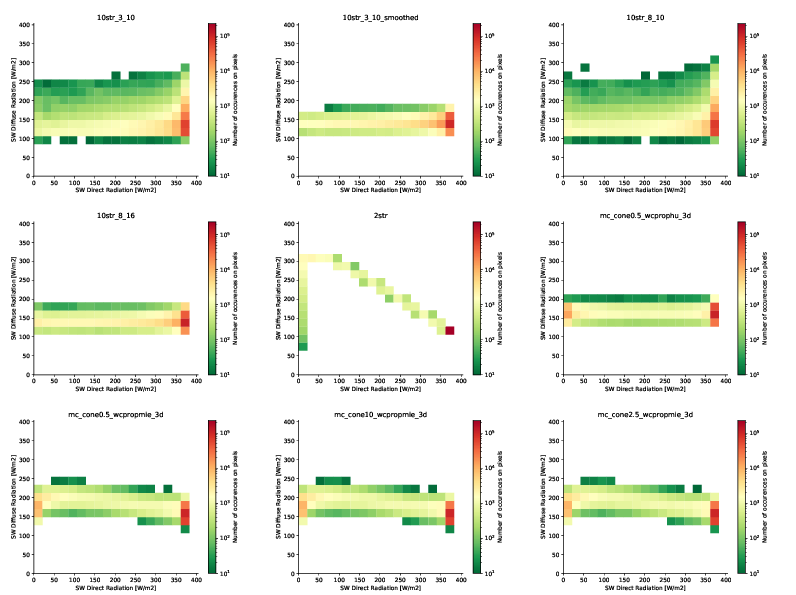Menno gave me some DALES cloud fields that he is working with with a request to compute the the partitioning of diffuse and direct radiation in comparison to 3D MonteCarlo results (MYSTIC). The simulations assume a constant surface albedo of 0.15 and solar zenith angle of \(60^\circ\).
Next, we find the MYSTIC and Twostream results following the partitioning for a 3_10 and 8_16 solver. For more information on the solver 3_10 and 8_16, see also Introducing new solvers into pprts
The following run parameters denote simulations with:
- 10str_3_10 — Tenstream with 3 direct and 10 diffuse streams
- 10str_3_10_smoothed — Diffuse Radiation smoothed with a gaussian blur with \(\sigma = 1km\)
- 10str_8_10 — Tenstream with 8 direct and 10 diffuse streams
- 10str_8_16 — Tenstream with 3 direct and 10 diffuse streams
- 2str — \(\delta\)-eddington Twostream solver
- mc_cone0.5_wcprophu_3d — MYSTIC result with a sundisk opening of .5 degrees and cloud droplet optical properties using Hu and Stamnes parametrization (using Henyey Greenstein as Scattering Phase Function)
- mc_cone0.5_wcpropmie_3d — MYSTIC result with a sundisk opening of .5 degrees and cloud droplet optical properties using precise Mie tables
- mc_cone2.5_wcpropmie_3d — MYSTIC result with a sundisk opening of 2.5 degrees
- mc_cone10_wcpropmie_3d — MYSTIC result with a sundisk opening of 10 degrees
Particulary interesting is the correlation of direct and diffuse radiation in case of 1D computations which is not realistic when compared to 3D radiative transfer. Furthermore we can immediately see that the Tenstream solver is generally not diffusive enough. This can be alleviated with either using more streams for the diffuse radiation (e.g. 16 -> costly) or smoothing the irradiance field with a generic gaussian blur(cheap). The smoothing technique was already investigated by panTICA and a MPI parallel version is available in the TenStream library.
A further, maybe surprising result is the small influence that the cone sampling strategy has. Cone sampling means, radiation that hits the surface is counted as direct if it comes from a cone around the sun direction with an opening angle smaller than .5, 2.5 or 10 degrees. For thick, distinct cumulus clouds, it makes sense not to show a large effect because radiation that hits a thick cloud will be scattered very often and loose any directionality. This would probably change if we had an aerosol or thin cloud layer with a optical thickness between 1 and 3.
On the other hand, we see the influence that the more correct Mie scattering phase functions have on the direct/diffuse partitioning has. However, it is unfeasible to use Mie tables in current radiative transfer solvers such as the twostream or TenStream.
The here presented works are a precursor to the research of Menno Veerman who investigates the non-linear interactions between radiation partitioning, plant evapotranspiration, surface/atmosphere exchange and boundary layer dynamics.
